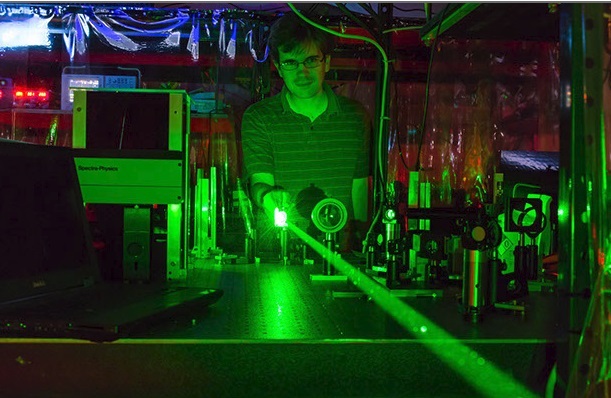Aug. 15, 2017
WASHINGTON – Conventional particle accelerators can range from large room-sized devices to facilities multiple kilometers across. One of the ways that scientists have looked to reduce the size and expense of future accelerators is by developing laser –driven plasma acceleration. Such accelerators, however, are growing in size and complexity in order to maintain relevance for one of their applications—high energy physics. However, there are many applications that can use a lower energy and higher repetition rate accelerated beam. For the first time, scientists have observed the production of relativistic electrons driven by low-energy, ultrashort mid-infrared laser pulses. A research team at the University of Maryland, USA, with support from the Technical University of Vienna, Austria, will present their group’s findings at Frontiers in Optics + Laser Science APS/DLS (FIO + LS), held 17-21 September 2017 in Washington, DC.
“We’re trying to develop laser-driven accelerators that are extremely compact and have a high repetition rate,” said Howard Milchberg, Fellow of The American Physical Society (APS) and The Optical Society (OSA), and professor of Physics and Electrical Engineering at the University of Maryland. “That means using as low a laser pulse energy as possible to generate relativistic electrons. Such sources could have use in rapid scan imaging for medical, scientific and security applications.”
Recently, the development of optical parametric chirp pulse amplification (OPCPA) systems in the mid-infrared has enabled the use of long wavelength pulses on the femtosecond scale. Until this development, long wavelength laser pulses have primarily been available from CO2 lasers, but they have a complicated multi-pulse structure with pulse durations extending, at the shortest durations, beyond several picoseconds, hundreds of times longer.
Common laser-driven acceleration experiments depend on short laser pulse interaction with a gas target. Compared to prior experiments, the long driver wavelength used in this project resulted in easy access to what is called the “critical density” regime. Because the critical density varies inversely as the square of the laser wavelength, gas targets used for mid-IR laser pulses can be up to 100 times less dense than those used in the visible and near-IR, making them far less difficult to engineer.
“When a few-millijoule femtosecond mid-IR laser pulses is focused by a curved mirror into a hydrogen gas jet – a stream of hydrogen puffing out of a nozzle – a collimated pulse of relativistic electrons beams out the other side of the jet,” Milchberg said, describing the experiment. “However, this can’t happen unless the laser achieves an extremely high intensity – much higher than achievable by focusing with the curved mirror alone. It does so by relativistic self-focusing in the ionized hydrogen gas so that it collapses to a size much smaller than its focal spot.”
The importance of being in the critical density regime, according to Milchberg, is that it promotes relativistic self-focusing even for low energy laser pulses. This boosted high-intensity interaction generates plasma waves that accelerate some of the electrons from the ionized hydrogen into a forward-directed relativistic beam.
The team found that electron beams were present for powers such that the characteristic self-focusing length in plasma was shorter than the, gas jet width, showing that electron acceleration cannot occur without relativistic self-focusing.
Relativistic self-focusing is an extreme example of the well-known process of self-focusing in nonlinear optics, but now with the bonus of accelerated relativistic particles generated from the nonlinear medium.
Even with only 20 millijoules of mid-IR laser energy, the laser in these experiments can significantly exceed the threshold for relativistic self-focusing, giving rise to relativistic multi-filamentation. The team observed multiple relativistic electron beamlets associated with these filaments.
These innovations are among the beginning steps for the development and applications of high repetition rate laser driven accelerators. “In particular,” Milchberg said, “long wavelength femtosecond lasers are especially promising, as they can access the relativistic nonlinear regime of free electrons surprisingly easily.”
About the Presentation
The presentation entitled "Laser wakefield acceleration with mid-IR laser pulses," by Daniel Woodbury, will take place from on Monday, 18 September at the International Ballroom East, Washington Hilton, Washington DC, USA.















